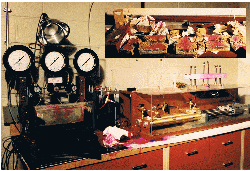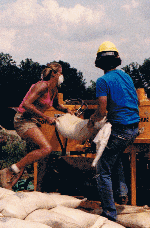Larry Murdoch and Bill Slack founded FRx in 1994 to develop and install innovative methods for controlling and monitoring physical and chemical conditions in subsurface formations, with particular emphasis on environmental processes related to the remediation of contaminated soil, bedrock, and groundwater.
|
 |
| Bench-scale tests proved the feasibility of creating hydraulic fractures in clay soil. Insert shows exposed fracture faces in cores (1986). |
|
Previously, they were adjunct faculty at the University of Cincinnati where they served as Principal Investigators of an off-campus research laboratory dedicated to the development and testing of methods to characterize and remediate contaminated soil. The United States Environmental Protection Agency funded many of the projects, and the work introduced and validated the technique of hydraulic fracturing, which greatly accelerates remediation of contaminated sites.
Much of what Larry and Bill accomplished at the University of Cincinnati drew upon their experience. As a geologist, Larry built upon the concepts of fracture mechanics that accompany magma intrusion during mountain formation. Bill, as an engineer, relied upon expertise developed while managing a team of petroleum engineers in West Texas where hydraulic fracturing was utilized daily.
|
 |
| Loading the mixer to create the first eFrac (1987). |
|
Objectives of the research and development efforts of the EPA funded projects included:
- Demonstrate at bench scale that soil can be fractured controllably.
- Identify delivery and recovery mechanisms that could be deployed at contaminated sites.
- Demonstrate application of hydraulic fracturing of soil at field scale in a clean test site.
- Develop and quantitatively calibrate a conceptual model for creation and propagation of shallow fractures in soil.
- Develop equipment of appropriate size scale for work at a contaminated site.
- Create the first hydraulic fracture in contaminated soil with the purpose of remediation - Oak Brook, Illinois (1990)
- Validate hydraulic fracturing as a remediation tool via participation in the EPA SITE program.
- Collaborate with other researchers nationwide.
- Summarize findings and results in peer-reviewed publications.
|
Innovation did not stop with the formation of FRx. Some of the notable achievements are listed below.
1995: FRx developed techniques to access deep, tough formations cost effectively - in essence the direct push methods utilized during the research programs were augmented with tooling deployed in wells cased with solid PVC.
1997: Larry and Bob Seigrist of Oak Ridge National Laboratory worked out a formula for the slurry transport of oxidative particles that destroy the guar used to suspend sand, ZVI, and other mildly reactive materials. This invention (US Patent 6102621)
extended the application of hydraulic fracturing to ISCO remedial precesses.
2001: FRx developed a multi-jet process to deliver slurry into under-consolidated and non-cohesive media.
2004: Equipment was developed to totally enclose reactive proppants, thereby suppressing dust hazards at job sites.
2005: FRx deployed medium pressure waterblast technology to initiate fractures in crystalline rock without reliance upon explosives, thereby precluding additional contamination of the site with RDX residuals.
2014: A method to initiate fractures in crystalline rock without waterblast technology or explosives was deployed.
|
|